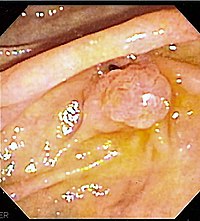
Photo from wikipedia
Rationale: Hemosuccus pancreaticus (HP) is a rare cause of gastrointestinal bleeding that sometimes leads to life-threatening conditions. However, the diagnosis of HP is often delayed due to its rarity and… Click to show full abstract
Rationale: Hemosuccus pancreaticus (HP) is a rare cause of gastrointestinal bleeding that sometimes leads to life-threatening conditions. However, the diagnosis of HP is often delayed due to its rarity and intermittent signs of bleeding, making it challenging to determine the source of bleeding in some patients. Patient concerns: An 83-years-old man was transferred to our hospital for evaluation of the source of intermittent upper gastrointestinal bleeding involving melena and worsening anemia. Diagnosis: HP was diagnosed via endoscopic retrograde cholangiopancreatography (ERCP) and sequential angiography using a multidisciplinary approach. Interventions: Initial upper and lower gastrointestinal endoscopies did not reveal any source of bleeding. Emergency upper endoscopy performed when the patient had hematochezia and hypotension confirmed a spurt of bleeding from the major duodenal papilla. However, contrast-enhanced computed tomography and angiography could not identify the source of the bleeding from the major duodenal papilla. ERCP for inducing bleeding from the source and indicating the bleeding point was performed according to the decision of the multidisciplinary team. Immediately thereafter, sequential angiography was performed and HP, due to the rupture of a pseudoaneurysm of the splenic artery, was diagnosed. As a result, surgical resection of the pancreas could be avoided by accurately embolizing the bleeding focus of HP using a multidisciplinary team approach. Outcomes: The patient was discharged in a hemodynamically stable condition. There was no further gastrointestinal bleeding or procedure-related complication until 6 months after discharge. Lessons: HP should be considered by endoscopists during the differential diagnosis of intermittent upper gastrointestinal bleeding in patients with a history of pancreatitis. A multidisciplinary team approach is an effective method to determine the source or location of bleeding, which may reduce mortality and morbidity by avoiding additional pancreatectomies.
Journal Title: Medicine
Year Published: 2022
Link to full text (if available)
Share on Social Media: Sign Up to like & get
recommendations!